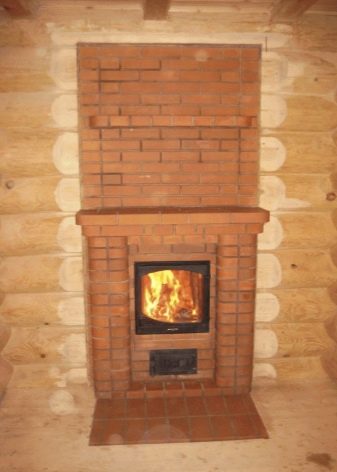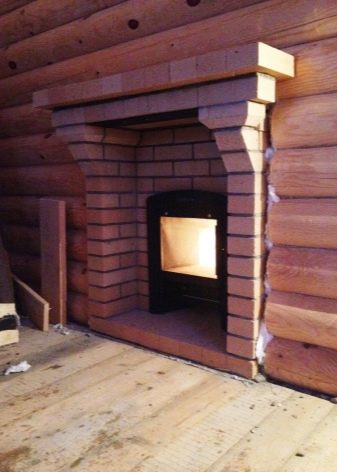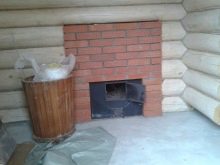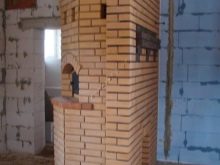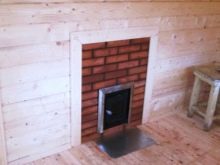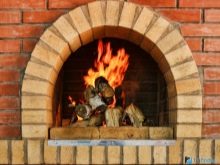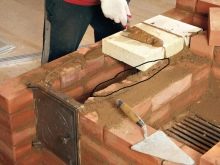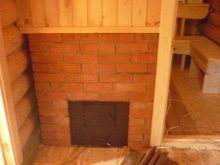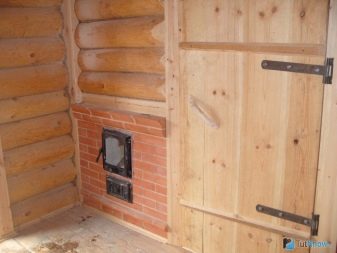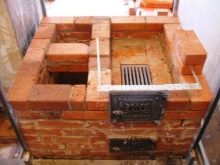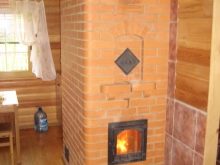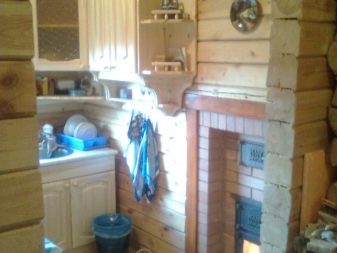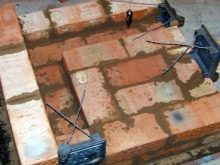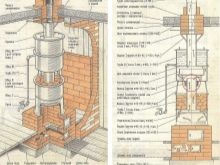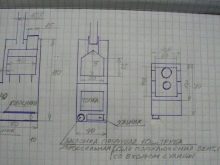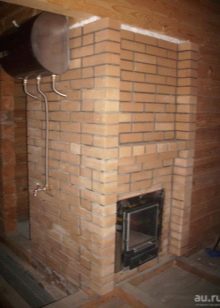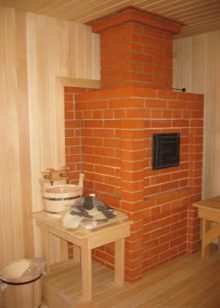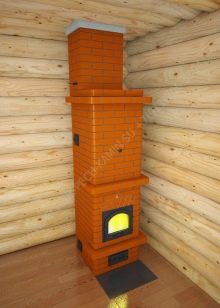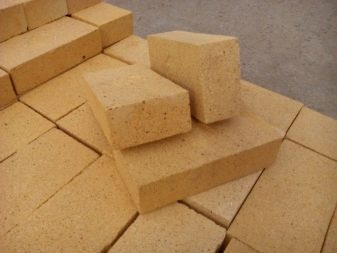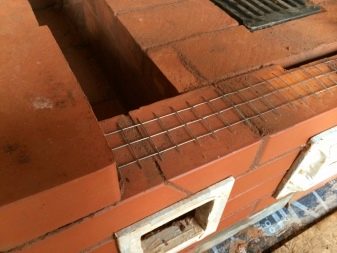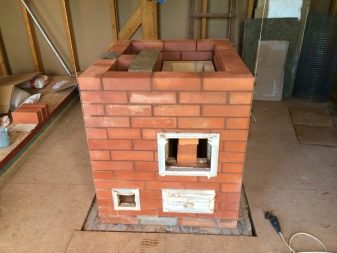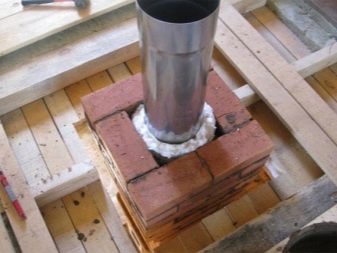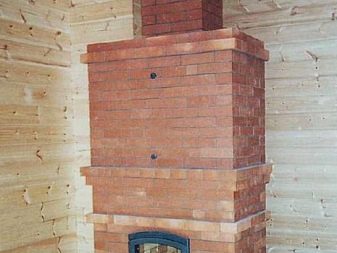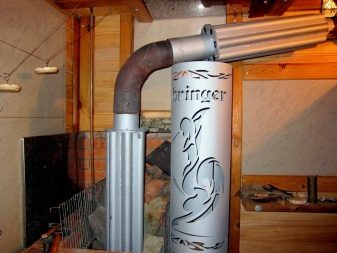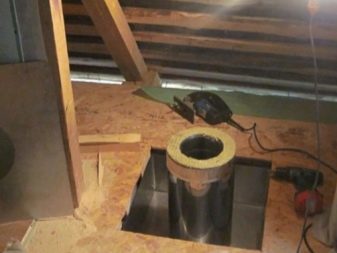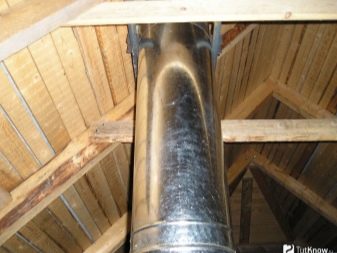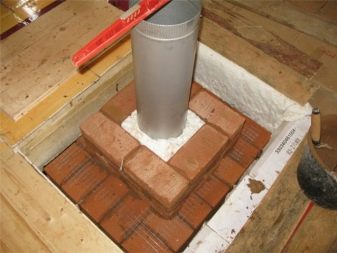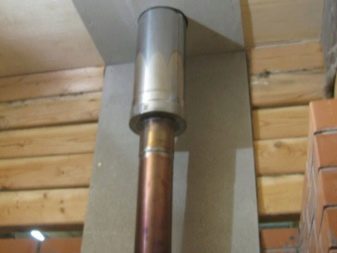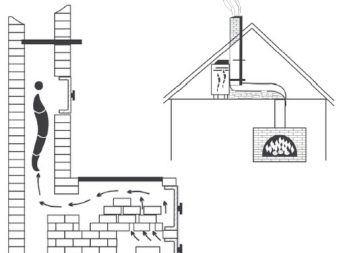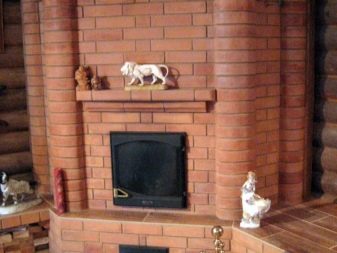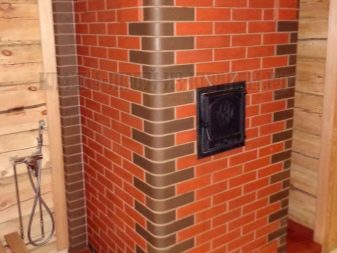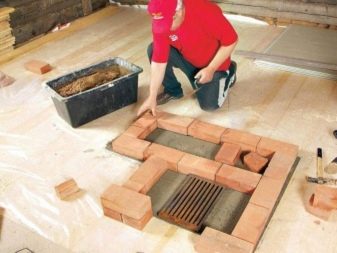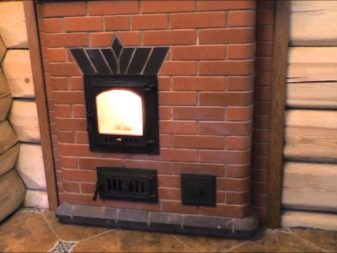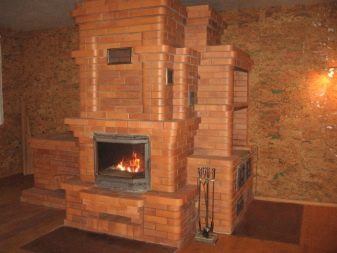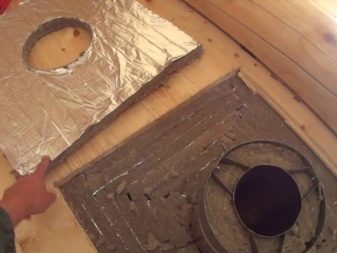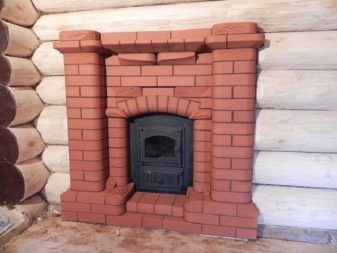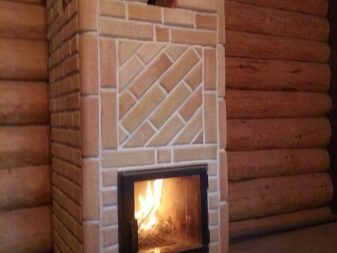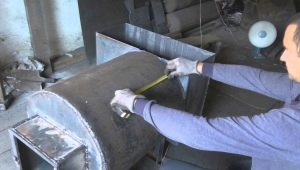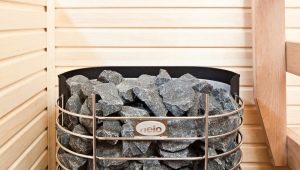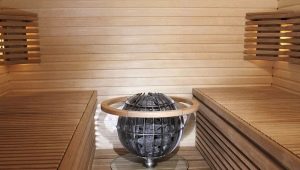The brick furnace for a bath with a fire chamber from a dressing room
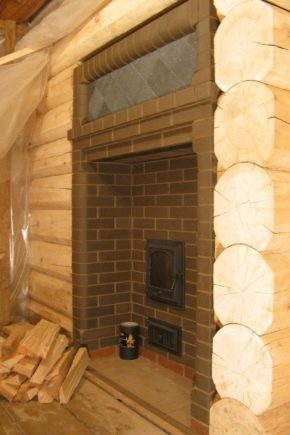
In order for the bath to live up to all expectations, it must have a good stove. It should perform the functions of a heating element, provide a safe and soft heat, and also provide heat to several rooms at once. In addition, the stove must ensure safe use.
All of the above requirements are met by a brick oven with a furnace from a waiting room.
Features: pros and cons
The design of a furnace with a firebox in the dressing room is more complicated than the design of a conventional furnace. The firebox is removable or part of the whole structure.
Despite the complexity of the implementation of such a project, you should pay attention to the following advantages:
- Two rooms warm up at once: a waiting room and a steam room. This creates additional convenience when preparing for bath events and staying in the dressing room after them;
- garbage along with firewood will not be brought into the steam room, which will ensure ease of cleaning, since dust will not turn into dirt in a damp room;
- it is convenient to organize a place to dry firewood near the firebox, which is not possible in the steam room;
- in the steam room you can install brick protection, which will prevent burns;
- in the steam room clean air will be preserved, uncontaminated by smoke from burning firewood when opening the door directly in the steam room;
- saving space in the steam room due to the lack of a firebox door;
- while heating the sauna, it will not be necessary to constantly go out and enter the steam room in order to throw firewood, which will not allow the room to cool down every time you open the door.
Along with all the advantages of a portable firebox, you can note such disadvantages as:
- installation complexity, especially for a beginner in this business. To implement such a project, it is better to seek advice from specialists;
- to maintain the temperature in the steam room will have to leave it on the less heated air.
The firebox can be placed not only in the waiting room. Sometimes she is taken out of the room.. This is realized if the waiting room is too small or if the bath is used for commercial gain.With such a device, the bathhouse attendant does not need to enter the premises of the guests, it can maintain the temperature in the steam room from the street.
The advantages of this option include protection against the spread of dirt in the premises.
Safety requirements
Material for the construction of the bath is most often initially dangerous for fires. To avoid fires, you need to follow the safety rules at the planning stage of construction. The first time after the construction of the wood bath will shrink, so before installing the furnace, it is necessary to make sure that the structure is sufficiently collapsed and will not crack.
Since in the bath the walls of the furnace unit are heated to high temperatures, which is fraught with harm to health in the form of burns, it is necessary to strictly follow the rules of fire safety when installing the furnace. Installation rules are prescribed in SNiP 41-01-2003 (chapter 6.6).
- Set a solid foundation under the base of the furnace. It will be adjacent to the wall between the waiting room and the steam room. It needs to be covered with heat-resistant material. If the basement is damaged, the stove may crack or squint, and this is dangerous due to the ignition of a wooden structure.
- From the oven door to the walls of the bath the distance should be not less than half a meter. If the oven is in the corner, then all the surfaces to which it adjoins must be insulated with heat-resistant material.
- If an easily combustible partition separates the dressing room and the steam room, the hole in which the fuel channel will be installed must be insulated from the tree with brickwork.
- All highly flammable materials must be impregnated with a special refractory agent.
- For use in the bath, the stove must be able to self-cool to a safe temperature of +80 degrees, since wood can spontaneously ignite from prolonged contact with a surface heated to +100 degrees.
- The chimney must be strong, made of safe material and with the correct geometry.
With heating you need to be careful. With self-assembly, the order should be observed and all the above recommendations should be taken into account. First of all, the scheme of work and the drawing of the future product must be prepared. In this case, the sink will not be scary.
DIY installation
To independently install a brick furnace for a bath with a firebox from the dressing room,The following preparatory work should be done:
- it is better to think over the place for installation of the furnace during the construction phase
- before starting work, the foundation for the stove is settled. To do this, pulled out the pit. Its bottom is covered with rubble, then sand and covered with waterproofing material. The foundation is strengthened with pieces of reinforcement and poured with concrete;
- bricks placed under the furnace;
- in the area of the firebox door a metal sheet is attached to the floor;
- the construction of the furnace, passing through the opening in the wooden wall, is lined with brick masonry;
- before laying the furnace, the bricks are immersed in water so that the pores of the material are filled with moisture;
- Insulating material is laid between the metal of the furnace and the brick.
After the preparatory work should proceed directly to the construction of the furnace:
- The first step is laid out brick oven itself. Brick, which laid out the walls of the house, will not work. For a bath stove you need one that has high heat resistance. It must be necessarily perfect shape, without cracks and chips.
- First, each row is laid out without using a solution.This is done to select the ideal bricks in shape and size. The laying of any of the rows begins with a corner brick.
- The first row is laid out from the corners on the perimeter. First, the solution is applied, then a series of pre-selected bricks are laid. Before laying each brick is dipped into the water for 20 seconds. The thickness of the seam should be no more than 5 mm.
- The second row is laid out with offset. The seams of the second row should be in the middle of the first. Similarly laid out the following rows.
- At the level of the fourth row is installed blowing door. It must be fixed with galvanized wire. On the side of the steam bath, a stone screen is used to protect against burns.
- The second stage is set the furnace door. It is fixed with galvanized wire twisted several times.
- Further, a chamber for stones is being constructed. The size is calculated based on the number of stones. At the end of her trim steel sheets.
- After the erection of the furnace of the desired height, a steel sheet is placed on top, on which a hole is pre-cut.
Chimney installation
The final step is to connect to the chimney stove.This can be done in several ways, using brick, metal or ceramics. Installation is external and internal. Proper installation of the chimney will not only save the room from soot and soot, but also save health from the harmful effects of combustion products of fuel.
Brick chimney is the safest in terms of fire safety, but its construction is a complex process. It is used to divert smoke from two or more furnaces. Ceramic chimney is heavy and expensive. However, it has good characteristics: resistant to corrosion, does not overheat, with a smooth surface inside, which prevents the accumulation of soot on the walls. This species is not very popular.
Metal chimney is easy to install, for the price it is affordable. Among the shortcomings, rapid heating is noted, and this is fraught with ignition. In addition, with the passage of hot air through the half of the pipe, located on the street, condensation forms. therefore in modern metal pipes used insulating material. The advantage of this type of discharge pipe is the absence of edges, which allows the smoke to go outside unhindered.
External chimney is a pipe that goes out of the wall and rises along it to the roof. To mount such a chimney is not difficult, both at the construction stage and in a ready-made bath. The advantages are safety, ease of maintenance. The minus is the need for pipe insulation so that when the temperature drops inside, condensate is not collected.
Installation of the pipe in the direction of the wall is carried out by means of a bend or knee. The section of the chimney passing through the brickwork of the wall is sealed with a metal box filled with heat-resistant material. The pipe is fixed vertically along the wall with holders. A protective fungus is placed on the top.
The indoor version of the chimney is a pipe that extends from the sauna stove to the ceiling through the attic and the roof. The advantage of this method is the preservation of heat in the bath room and attic longer. Of the minuses - is the complexity of installation through the roof.
Collect the chimney from several parts, any higher part is worn on the bottom, and then well fastened clamps. Before fixing the elements of the joints are lubricated with heat-resistant sealant. Then the pipe is led through the ceiling and the roof.
The places of passage of the pipe from the inside and outside are protected by a roof sheet and a roof cut. Heat-resistant insulation is laid around the pipe.
After laying the roof, waterproofing is carried out to prevent water from entering the joints. A protective umbrella is installed on top of the pipe.
Tips and tricks
Experts recommend to adhere to the following rules:
- first of all, when installing the furnace in a bath, it is necessary to act in accordance with the rules of SNiP. This will ensure safety during operation and extend the service life of the heating element;
- you should not save on materials, especially on heat-resistant insulation;
- when choosing a place for a bath, it is better to give preference to a detached structure. If the bath is an extension to another building, then you need to take care of the insulation of the adjacent wall;
- When choosing a brick, you need to pay attention to its heat-resistant and moisture-proof properties. If finances do not allow you to purchase an expensive brick that meets these requirements, you can cover a more affordable brick with a special compound;
- a hole for the foundation must be excavated more than the size of the furnace. The base of the stove must be 10 cm larger than the perimeter of the heater on all sides;
- In the laying of the furnace, you can use bricks with minor defects, but it is impossible to lay the damaged brick inside the smoke channel and on the outside of the furnace, as well as to chop the chipped edges and corners so that the laying does not result in too thick joints;
- When installing the stove in the wall of the bath, it is necessary to follow the characteristics of the unit described in the accompanying instructions. If the furnace is made independently, then you need to take the average power values;
- The ideal chimney should be without knees and 2 m in height. This will ensure normal traction;
- after installation, the furnace should be heated several times in a gentle mode for half an hour to check its correct operation and drying. It is necessary to dry the furnace so that cracks do not appear during operation;
- for several days, the stove door, as well as the windows and doors of the bath should be kept open, creating a draft in the room. A sign of readiness of the furnace will be the absence of condensate on the valve;
- Despite the observance of fire safety rules and the use of a high-quality stove, you need to remember about fire extinguishing agents. They must be available at all times;
- most often the center of ignition is the ceiling. Therefore, do not forget about his protection. It should be covered with a metal sheet;
- in the bath should be as safe as possible even in case of poor health of visitors. The furnace must be protected by a protective screen.
The process of installing the furnace in the bath with his own hands is time consuming, but if all the recommendations are followed, we will perform. In case of following all the requirements, depending on the characteristics of the furnace and the room of the bath and the correct installation, the furnace will serve properly and for a long time. Therefore, we should not ignore the recommendations and advice, take a responsible attitude to the construction of a place to rest with soul and body.
It would not be out of place to look at the stove-maker, experienced in this matter, especially when building a brick stove. At the same time, a self-built sauna with a stove will be the pride of the owner.
More information about the construction of a brick furnace for a bath, see the following video.
